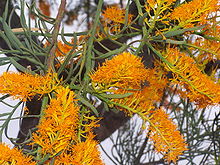Nuytsia floribunda
| Nuytsia floribunda | ||||||||||||
|---|---|---|---|---|---|---|---|---|---|---|---|---|

Nuytsia floribunda |
||||||||||||
| Systematics | ||||||||||||
|
||||||||||||
| Scientific name of the genus | ||||||||||||
| Nuytsia | ||||||||||||
| G.Don | ||||||||||||
| Scientific name of the species | ||||||||||||
| Nuytsia floribunda | ||||||||||||
| ( Labill. ) R.Br. ex G.Don |
Nuytsia floribunda is the only way the plant genus Nuytsia within the family of loranthaceae (Loranthaceae). It isnativeto Australia . It lives - unusual for mistletoe - as a root parasite, which, like most types of mistletoe, also feeds itself through photosynthesis.
description
Appearance and leaf
Nuytsia floribunda grows as an evergreen, small tree , shrub or tree-shaped and reaches heights of growth of up to about 10 meters. The abnormal secondary growth occurs around a concentric cambium. It is a semi-parasite on the roots of the host plants. Nuytsia floribunda forms haustorial roots. The contact organs were described by Thomas Göbel as pincer-shaped. They are said to have even cut underground cables on occasion. The bark is rough and gray-brown.
The leaves are well developed or are reduced to scales in the lower part of the stems. The alternately arranged leaves are sitting. The simple, somewhat fleshy or leathery, bald blade is usually linear or, more rarely, egg-shaped with a tapering upper end. There are no stipules .
Inflorescence and flower
The flowering time in the Australian summer (southern hemisphere) extends from October to December or January, this flowering time around Christmas led to the common English name “Western Australian Christmas Tree”. The flowers of Nuytsia floribunda are monoecious, separated from the sexes ( monoecious ). In lateral or terminal branched, racemose total inflorescences there are up to 50 stalked, zymous partial inflorescences with about three flowers each, of which the middle one is female and the lateral ones are male. Under each flower there is a durable, sloping, triangular bract . There are two bracts just below each flower .
The always unisexual flowers are functionally male or female. The stalked or sessile flowers are more or less radial symmetry . The receptacle (receptacle) is clearly hollow. There is a free flower cup (hypanthium). The calyx tube is fused with the ovary. The six to eight free petals are linear and golden yellow to orange in color. There are six to eight free, fertile stamens in functionally male flowers . The anthers open with a longitudinal slit. In functionally female flowers are three or four carpels an under standing, single-chamber ovary grown. The four to twelve sessile ovules are not clearly differentiated from the placenta . The single stylus ends in a simple scar.
Fruit and seeds
The lock fruit contains a seed. The seed contains abundant oily endosperm . The seed has no seed coat (testa), but is covered with sticky material. The well-developed embryo has two or one cotyledon ( cotyledons ).
Multiplication
Mainly because of the problematic proliferation is Nuytsia floribunda barely culture . Propagation from seeds and cuttings is quite possible, but the young plants usually die after a year or two, possibly because the suitable host plants are not available.
Occurrence
Nuytsia floribunda is only native to southwestern Western Australia . Their distribution area extends from the Murchison River to the western end of the Great Australian Bay . It occurs on sandy or granitic soils in open forests and woodland as well as heathland.
Systematics
The first description was in 1805 under the name ( Basionym ) Loranthus floribundus by Jacques Julien Houtou de Labillardière in Novae Hollandiae Plantarum Specimen , 1 (11), p. 87, plate 113. The genus Nuytsia was in 1834 by George Don in A General History of Dichlamydeous Plants , 3, p. 432 with the type species Nuytsia floribunda (Labill.) R.Br. ex G.Don set up. Nuytsia R.Br. is just a synonym. nom. inval. as this name was given by Robert Brown in General view of the botany of the vicinity of Swan River. Journal of the Royal Geographical Society of London , 2nd edition, Volume 1, 1831, p. 17 is mentioned, but no description has been made and thus it is not a valid first publication.
The generic name Nuytsia honors Pieter Nuyts (1598–1655); he was a Dutch researcher who, among other things, mapped the South Australian coast. The specific epithet floribunda is derived from Latin and means "richly blooming".
Nuytsia floribunda is the only species of the genus Nuytsia in the tribe Nuytsieae within the family Loranthaceae .
Others
The botanical journal Nuytsia , published by the Western Australian Herbarium , is named after the genus Nuytsia .
Individual evidence
- ↑ a b c d Species and genus entry in Western Australian Flora .
- ↑ a b Nuytsia floribunda at Australian Native Plants Society (Australia) = ANSPA. (English short description)
- ↑ Entry at Australian Plant Name Index = APNI.
- ↑ Nuytsia in the Germplasm Resources Information Network (GRIN), USDA , ARS , National Genetic Resources Program. National Germplasm Resources Laboratory, Beltsville, Maryland.
- ↑ Nuytsia .
Supplementary literature
- Ainsley Calladine & John S. Pate: Haustorial Structure and Functioning of the Root Hemiparastic Tree Nuytsia floribunda (Labill.) R.Br. and Water Relationships with its Hosts . In: Annals of Botany . Oxford 85, 2000, ISSN 0003-4754 , pp. 723-731 .
- Thomas Göbel: Nuytsia floribunda and Viscum album: Medicinal plants against cancer and psychosis . Consideration and assessment of two polar plant characters and their possible uses. Free Spiritual Life, Stuttgart 2004. ISBN 3-7725-2230-0





